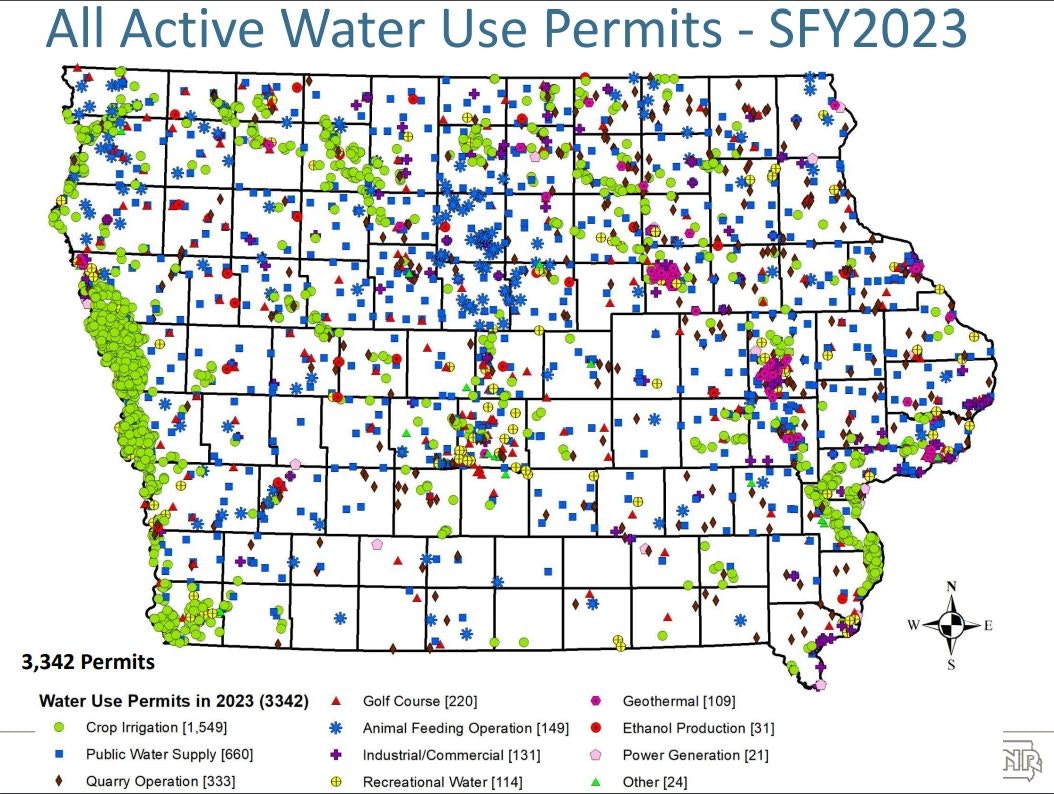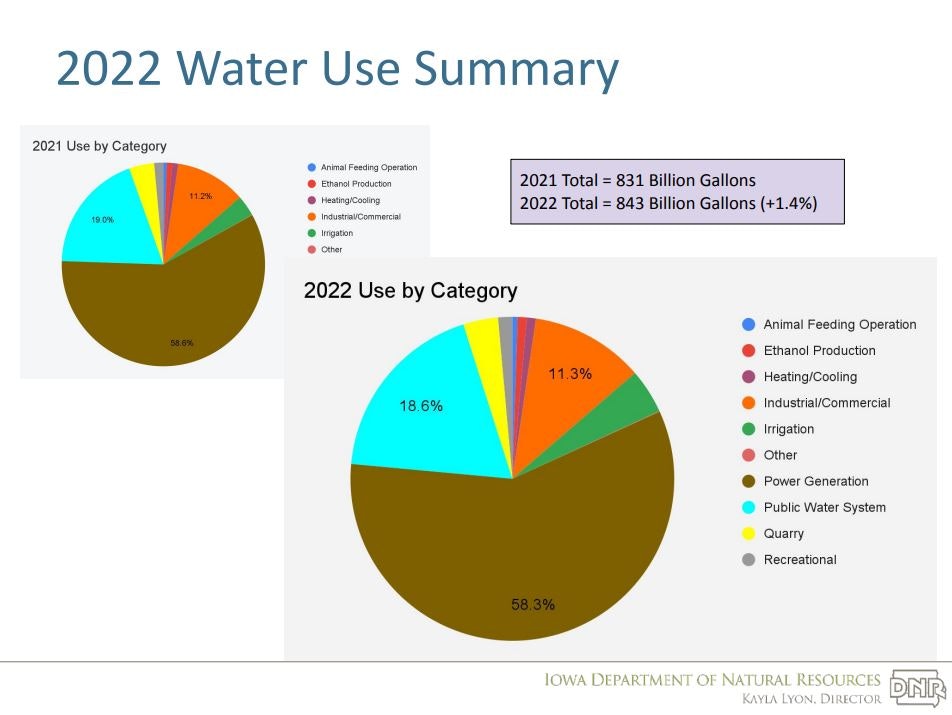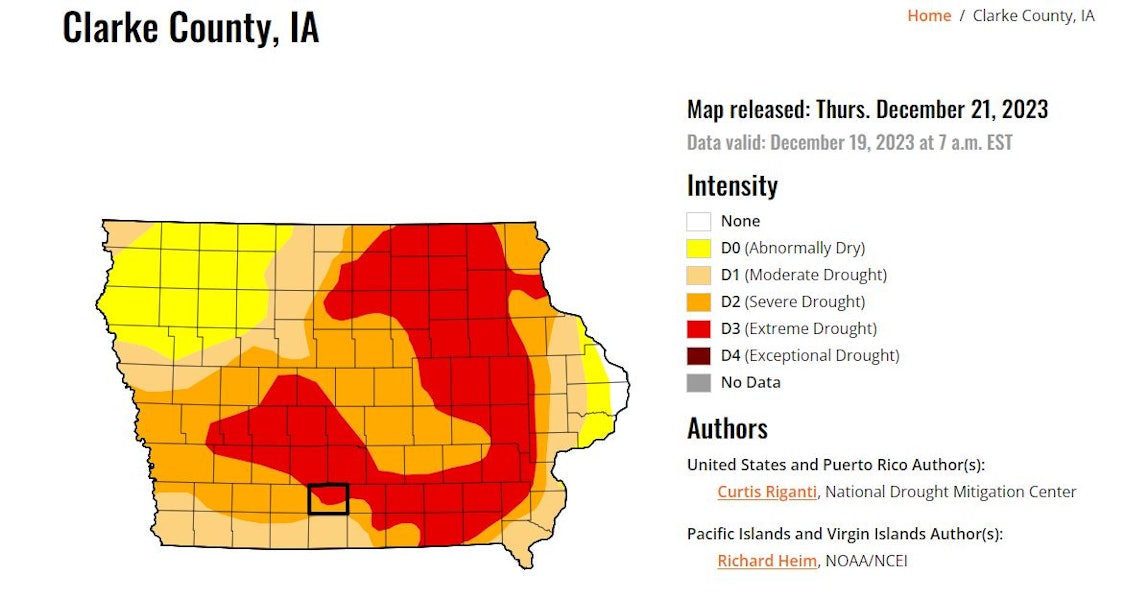Nancy Dugan lives in Altoona, Iowa and has worked as an online editor for the past 12 years.
A labyrinth of limited liability companies own numerous animal feeding operations in Clarke County that continue to rely on the city of Osceola’s depleted water supply, even as city residents face restrictions since the Osceola Water Works Board of Trustees declared a water emergency on October 5.
A search of the Iowa Department of Natural Resources’ (DNR) animal feeding operation website identifies 27 animal feeding operations in Clarke County. The chart below identifies these facilities, the majority of which appear to house hogs in enclosed structures commonly known as confined animal feeding operations, or CAFOs.
According to information gleaned from the DNR’s animal feeding operation website, the total number of hogs and cattle approved in Clarke County through permits issued by the DNR is 78,568. By way of comparison, the U.S. Census Bureau estimated the population of Clarke County at 9,692 as of July 1, 2022. In other words, the population of hogs and cattle permitted for animal feeding operations in Clarke County is more than eight times greater than the county’s human population.
It is important to note that compared to many other Iowa counties, Clarke’s livestock population is modest. For example, the DNR website identifies more than 260 animal feeding operations in both Hardin and Kossuth Counties. In his 2023 book The Swine Republic: Struggles with the Truth about Agriculture and Water Quality, Chris Jones estimates that Iowa has “20-24 million hogs, 250,000 dairy cattle, 1.8 million beef cattle, 80 million laying chickens, and 4.7 million turkeys.” (p. 42)
Stunningly, in a July 19, 2023, publication produced for its Water Use Program Annual Stakeholder Meeting, the DNR identified a mere 149 animal feeding operations that held water use permits in Iowa. This means that thousands of these facilities operate with little or no apparent state oversight of their water use.
The DNR also identified only 31 ethanol plants that held water use permits. The Iowa Renewable Fuels Association puts the number of ethanol refineries in Iowa at 42.

Screenshot of p. 22, DNR’s Water Use Program 2023 Annual Stakeholder Meeting
Bleeding Heartland sought comment from the DNR and the governor’s office for this story. Neither responded.
It is not known whether the DNR relies solely on its Water Allocation Compliance and Online Permitting (WACOP) data to calculate water use for animal feeding operations and ethanol plants. If that is the case, then these figures likely underestimate water use in both industries.

Screenshot of p. 8, DNR’s Water Use Program 2023 Annual Stakeholder Meeting
CLARKE COUNTY LIVESTOCK FACILITIES UNDER NO FORMAL RESTRICTIONS
To date, none of the Clarke County facilities have faced water restrictions, according to the Southern Iowa Rural Water Association (SIRWA), which purchases water from Osceola Water Works at a rate of 350,000 gallons per day and supplies most of these facilities. This figure applies exclusively to SIRWA customers who reside in unincorporated areas of Clarke County.
- 350,000 x 365 = 127,750,000 (one hundred twenty-seven million, seven hundred fifty thousand) gallons per year
SIRWA’s website indicates the association was founded in 1975 and is considered a governmental entity under Iowa Code chapter 357A. Presently, it provides water to “all unincorporated areas of the Iowa counties of: Adams, Clarke, Decatur, Ringgold, Taylor, and Union along with portions of Adair, Cass, Lucas, Madison, Montgomery, Page and Warren counties.”
A search of the DNR’s online WACOP system did not yield any results directly associating SIRWA’s water use with Osceola Water Works.
The DNR granted SIRWA a permit through its WACOP application system on July 24, 2023, to withdraw 7,921 acre-feet per year at a rate of 7,800 gallons per minute from Three Mile Lake in Union County.
- 7,921 acre-feet per year = 2,581,069,165.7 gallons of water per year (two billion five hundred eighty-one million sixty-nine thousand one hundred sixty-five and seven tenths)
- 7,800 gallons per minute x 1,440 (minutes in a day) = 11,232,000 gallons per day
- 11,232,000 gallons x 365 (days in a year) = 4,099,680,000 gallons of water per year (four billion ninety-nine million six hundred eighty thousand)
The city of Osceola’s Water Board of Trustees, which manages Osceola Water Works, is permitted through the WACOP system to withdraw 550 million gallons per year (MGY) at a rate of 2,500 gallons per minute.
SIRWA’s Union County water permit is for a new water treatment plant near Afton. According to Brenda Standley, SIRWA’s general manager of administration, and Jeff Rice, SIRWA’s general manager of systems, the new water treatment plant is currently undergoing testing and is scheduled to be operational in the coming weeks or months.
The SIRWA website documents the treatment plant’s progress: “The new treatment plant will have a capacity to treat water at 6.0 Million Gallons per Day (6 MGD). SIRWA has built additional capacity into the piping inside the plant so it can be expanded by an additional 2.0 MGD for an 8.0 MGD plant, if needed in the future.”
- 6 million gallons per day x 365 (days in a year) = 2,190,000,000 (two billion one hundred ninety million)
- 8 million gallons per day x 365 (days in a year) = 2,920,000,000 (two billion nine hundred twenty million)
CLARKE AND UNION COUNTIES IN SEVERE TO EXTREME DROUGHT
In a December 18 email, Standley and Rice stated that the amount of water SIRWA purchases from Osceola Water Works is expected to drop to 50,000 gallons per day once the Union County site is fully operational.
Bleeding Heartland asked Brandon Patterson, Water Superintendent for Osceola Water Works, whether the city of Osceola has the ability to purchase water from SIRWA’s Union County facility. Patterson stated that it did not have that ability at this time. He also indicated that Osceola Water Works is exploring other possible alternative sources of water.
Like the majority of Iowa counties, Union County is in the grips of a protracted drought. The most recent Iowa map from the U.S. Drought Monitor, issued on December 21, indicates that most of Union County is in a severe drought, with the uppermost northeast quadrant now categorized as extreme. According to the National Integrated Drought Information System, the U.S. Department of Agriculture has designated 64 Iowa counties as disasters due to the drought.
It is not known how this might affect the operations of SIRWA’s new water treatment plant if the drought continues to worsen. Large portions of Clarke County (outlined in black on the map below) are now in an extreme drought (shown in red), and Union County neighbors Clarke to the west.

Courtesy of U.S. Drought Monitor
One of the largest animal feeding operations in Clarke County is an entity identified as CRE Holdings, LLLP. It is affiliated with Cactus Family Farms, LLC, whose principal office is in Amarillo, Texas. CRE Holdings, LLLP’s home office is in Webster City according to the Secretary of State’s website, and its registered agent is Amy A. Johnson, an attorney with the BrownWinick law firm in Des Moines.
According to the DNR’s website, CRE Holdings, LLLP is permitted to house 28,602 hogs in Clarke County. Additionally, combined, Big Valley Farms, LLC, Southern Farms, LLC, DLH Enterprises, LLC, and TRP Farms, LLC, all of which appear to be tied to Iowa Select Farms, are permitted to house 30,736 hogs in Clarke County. Johnson, who is also listed as the registered agent for those CAFOs, declined comment for this story.
In their 2023 Biennial Reports, which are filed with the Secretary of State, Big Valley Farms, Southern Farms, DLH Enterprises, and TRP Farms all identified themselves as family farm limited liability companies. DLH Enterprises has a total of 12 iterations on the Secretary of State’s website, all of which identified themselves as family farm limited liability companies (see Iowa Code chapter 9H) in their 2023 Biennial Reports.

The contact for three of the privately owned Clarke County hog confinements is Seth Wengert, co-owner of AgVice, LLC. That company’s website claims AgVice is “Iowa’s leader in manure management plans & environmental compliance.” Combined, these three sites are permitted to house 7,497 hogs.
Canyon Creek Farms, LLC is also privately owned. It is permitted to house 4,960 hogs, and its contact is Brian Ritland, director of agronomy for the Pinnacle Group in Iowa Falls. Pinnacle’s website says the firm’s mission is “to offer our knowledge and experience in environmental and regulatory compliance, to result in lower input costs and higher revenues for our clients.”
It is not known if any of these facilities are in a contractual relationship with hog integrators or their intermediaries, an arrangement whereby pork producers—such as China-based Smithfield or Brazil-based JBS—contractually own or manage animals placed on farms, which these producers then process once they’re ready for market.
WILL PEOPLE PREVAIL BEFORE HOGS?
Bleeding Heartland asked SIRWA to provide water usage figures for all of the animal feeding operations listed on the chart found in this article. In a December 18 email, Standley and Rice replied, “We are unable to provide information on the facilities as listed. The facility names from your chart do not match how these customers are listed in our billing system.”
As part of its October 5 resolution, the Osceola Water Board of Trustees restricted residential use to “7,000 gallons of water usage per billing period.” Osceola residents were also recently asked to use bottled water for drinking.
On December 15, KCCI-TV reported on one Osceola father of a family of six, Joshua Verwers, who displayed a recent water bill of $285.45. The bill included a penalty for exceeding the 7,000-gallon restriction.
Iowa Code section 455B.266 governs priority water allocations following certain events in the state. Under section 455B.266(2)(g) and (h), uses of water for human consumption take priority over uses of water for livestock production when the DNR implements the state’s priority action plan. The statute may become increasingly relevant if the drought continues to worsen in Iowa.
Bleeding Heartland is not aware of any public actions or announcements from the DNR to address the crisis in Osceola. It is not clear whether the agency or some livestock operations in Clarke County have taken actions behind the scenes to lower water usage.
Near the bottom of a Drought Information Statement for Central Iowa, issued on December 14, the National Weather Service predicted, “Drought conditions are expected to persist across Iowa through the end of December.”
The DNR, the Iowa Department of Agriculture & Land Stewardship, and the Iowa Department of Homeland Security and Emergency Management issued an Iowa Drought Plan in January 2023. Page 12 of that plan read in part,
While the Iowa DNR is authorized by Iowa Code to allocate water for priority uses, this authority has never been utilized to date. However, a drought emergency could be an instance where use of such authority could be required to protect health and safety.
Under section 6.1, Sectoral Risk (p. 15), the drought plan identified the agriculture and irrigation sector first, stating, “The agriculture and irrigation sector is usually the first sector to be affected by drought conditions.”
Regarding the public health and safety sector (p. 21), the drought plan stated the following:
Drought can have a number of effects on the public health and safety sector. The most obvious problem is a lack of access to water for human consumption and sanitation. These, however, are the best-protected uses of water in Iowa’s water prioritization scheme (Iowa Code § 455B.266). Other sectors (e.g., irrigation or industry) will typically be restricted first. […]
As mentioned above, the agricultural sector is usually the first affected by drought. This cascades to the public health sector due to the potentially devastating mental health toll that crop and livestock losses can take on farmers, ranchers, and rural communities, especially those lacking insurance.
On page 28 of the plan, under a list of possible actions the state may take, Action ID number 2.8 states the following: “Incentivize or require water suppliers to confidentially share supply and demand forecasts with the Drought Coordinating Team.” Why such information would be deemed confidential is not clear.
The drought plan talks about relocating livestock from drought-stricken areas and potential actions to accomplish this. However, it makes no mention of the possibility of reducing livestock production levels. In Iowa, a state once heralded for its common sense, some may wonder why government officials didn’t consider that prospect long ago, before residents began to run out of drinking water.
FINAL NOTE: IOWA DROUGHT PLAN CALLS FOR TRANSITION AWAY FROM ENERGY SOURCES REQUIRING WATER FOR COOLING
An interesting aside can be found on page 29 of the Iowa Drought Plan. Among possible actions the state of Iowa is considering to mitigate the drought, Action ID number 4.14 states, “Continue transitioning to energy sources that do not require water throughput for cooling.”
Under Potentially Assisting Party(ies): “IUB, IEDA, DOC.” Under Type: “Infrastructure.” Under Notes: “Most fossil-fuel and nuclear energy facilities use water for cooling, which has a warm water effluent that might not be permissible during low streamflow. Improved battery capacity may be required for other energy sources.”

In other words, the Iowa Utilities Board (IUB) is identified as a potentially assisting party in reducing uses of water for cooling energy sources. That goal would appear to apply to both ethanol facilities and proposed adjacent CO2 capture facilities. Should the IUB approve the Summit Carbon Solutions permit to build a CO2 pipeline across Iowa, it would likely lead to significant increases in water use at both ethanol and adjacent CO2 capture facilities.
That’s because Summit Carbon founder Bruce Rastetter has acknowledged water-intensive ethanol production will increase in Iowa if the CO2 pipeline is approved. The proposed CO2 capture facilities will require significant amounts of water for cooling.
Additionally, CO2 is increasingly being utilized as an energy source in the production of sustainable aviation fuel.
Top image is by Alter-ego, available via Shutterstock.


3 Comments
Hog Barons rule, peasants lose...
thanks for tracking all of this, Austin Frerick tried to warn us but no one really listened to him and fewer voted for him:
https://www.vox.com/the-highlight/22344953/iowa-select-jeff-hansen-pork-farming
dirkiniowacity Sat 23 Dec 12:32 PM
Nancy Dugan, I'm not entirely sure at this point that Iowa deserves all your hard work...
…but Iowa certainly does need it. Thank you.
PrairieFan Sat 23 Dec 2:20 PM
Highlighting the drip of water problems-quality and quantity.
Art Cullen just wrote about water problems in Storm Lake. I did some quick research on the website of the Iowa League of Municipal Utilities to see if these problems are discussed. Unfortunately, this trade association of municipal utilities did not indicate if these are isolated problems or the future of Iowa public drinking water systems.
iowaralph Wed 27 Dec 4:24 PM